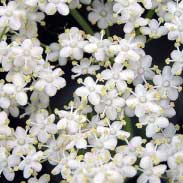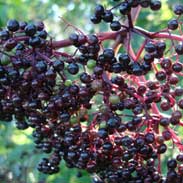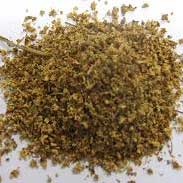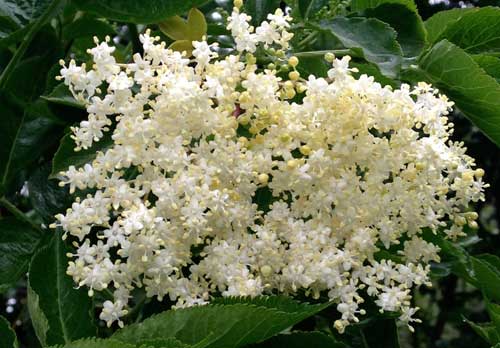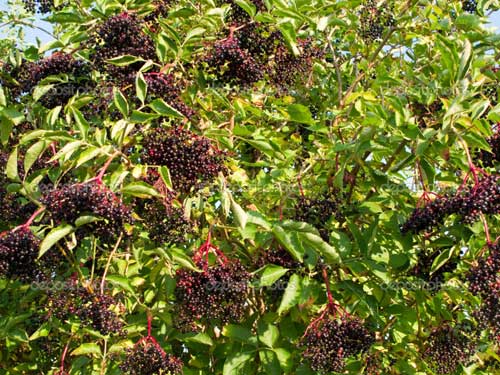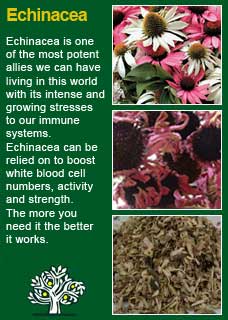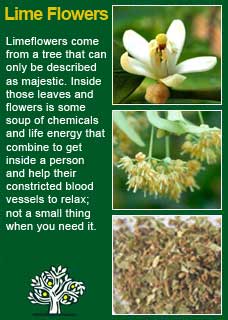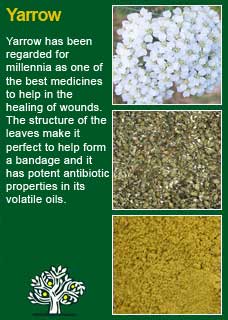
|
|
||||
| Our Pages ABOUT CONSTITUTIONAL MEDICINE
|
The flowers and berries of Elder, the familiar scraggly tree that grows in many a backyard with the owners being none the wiser that they have one of the great medicine chests of Nature right outside their door!
Elder tea is an ancient remedy for colds, flus and fevers and for promoting the flow of urine. Elder helps heal grazed skin soothes sore or inflamed eyes. Elder berries contain ingredients that boost immunity and help the body fight the flu virus. Hoffmann writes 'the Elder tree is a medicine chest in its own right. The leaf is used topically for bruises, sprains, wounds and chilblains... Elder flower is ideal for the treatment of colds and influenza... and the Berry has demonstrated antiviral properties. Elder flower is indicated for any catarrhal inflammation of the upper respiratory tract, such as hay fever or sinusitis. Catarrhal deafness responds well to Elder flower. Elder berry has properties similar to those of the flower, with the addition of effectiveness in rheumatism'. Hoffmann says the actions of the flowers are 'diaphoretic, anticatarrhal, antispasmodic, and the actions of the berries are diaphoretic, diuretic, laxative and antirheumatic. T. J Lyle wrote 'the flowers are a mild, diffusive, relaxing diaphoretic. When given in hot infusion it is excellent for the removal of colds and feverish conditions, also in measles and chicken pox. It influences the glandular system and is an excellent addition to alterative (blood-purifying) compounds. Its relaxing influence is felt by all the organs of secretion. It is a gentle laxative for children and is very soothing to the nerves' WM Cook writes 'the flowers contain a small quantity of volatile oil, which may be obtained by distillation, and becomes as stiff as butter on cooling. Their aroma, when fresh, is strong and rather pleasant; but becomes feeble by age. An ounce to a quart of water makes an infusion that is diffusibly relaxant and mildly diaphoretic, gently nervine, and useful in measles, recent colds, and as a soothing diuretic' Priest & Priest saw Elderflower combining with Yarrow for acute colds and influenza and the British Herbal Pharmacopoeia (BHP) cites its actions as anticatarrhal and diaphoretic, recommending it for 'influenzal colds, chronic nasal catarrh with deafness and sinusitis'. The BHP also suggest combining it with Peppermint for colds and influenza and with Hyssop and Yarrow for fevers and catarrh. Rudolph Weiss writes 'Elder juice is an old folk remedy; this refreshing and revitalising juice is a very popular beverage, often taken in 'spring cures' which do indeed improve the body's resistant to disease'. Weiss goes on to give this simple recipe as an example: Chevallier writes that 'Elder has more folklore attached to it than almost any other European plant, except perhaps Mandrake' In her book, a Modern Herbal, Maude Grieve devotes many pages to the history and uses of Elder, she writes 'even in these prosaic days, one sometimes comes across a hedge-cutter who cannot bring himself to molest the rampant growth of its spreading branches for fear of being pursued by ill-luck. An old custom among gypsies forbade them using the wood to kindle their camp fires and gleaners of firewood formerly would look carefully through the faggots lest a stick of Elder should have found its way into the bundle, perhaps because the Holy Cross was believed to have been fashioned out of a giant elder tree, though probably the superstitious awe of harming the Elder descended from old heathen myths of northern Europe. In most countries, especially in Denmark, the Elder was intimately connected with magic. In its branches was supposed to dwell a dryad, Hylde-Moer, the Elder-tree Mother, who lived in the tree and watched over it' Grieve also writes that 'an almost infallible cure for an attack of influenza in its first stage is a strong infusion of dried Elder Blossoms and Peppermint. Put a handful of each in a jug, pour over them a pint and a half of boiling water, allow to steep, on the stove, for half an hour then strain and sweeten and drink in bed as hot as possible. Heavy perspiration and refreshing sleep will follow, and the patient will wake up well on the way to recovery and the cold or influenza will probably be banished within thirty-six hours' King's Dispensatory writes 'In hot infusion, elder flowers are diaphoretic and gently stimulant; in cold infusion, they are diuretic, alterative, and cooling, and may be used in all diseases requiring such action The expressed juice of the berries, evaporated to the consistence of a syrup, is a valuable aperient and alterative. The flowers and expressed juice of the berries have been beneficially employed in scrofula, cutaneous diseases, syphilis, rheumatism, etc. The chief indication for Elder is a fullness or oedematous condition of the parts, giving them a watery and flabby appearance'
I've followed the scientific literature on Elderberry with keen interest, in particular its ability to assist with fighting the influenza virus and have put together a page with some more detailed descriptions of some of that research that you can find, it's here There is a real possibility that at some time in the future there will be another mutation of the flu virus from animals to humans that will prove to be really deadly - don't forget about Elder berry if this dreadful possibility turns into a reality
Theoretically, elderberry might interfere with immunosuppressant therapy because of its immunostimulating activity. Elderberry stimulates production of cytokines including interleukin and tumor necrosis factor. Immunosuppressant drugs include azathioprine (Imuran), basiliximab (Simulect), cyclosporine (Neoral, Sandimmune), daclizumab (Zenapax), muromonab-CD3 (OKT3, Orthoclone OKT3), mycophenolate (CellCept), tacrolimus (FK506, Prograf), sirolimus (Rapamune), prednisone (Deltasone, Orasone), and other corticosteroids (glucocorticoids).
For some years now, against this proven and safe way of herbalism, there has been a rising tide of excessive caution and scare-mongering in many parts of the world. The same authorities that, not so long ago, decried herbal medicines as ineffectual, have now taken up a different adversarial position; that they are dangerous substances that should only be prescribed by Doctors, who of course have zero training in them. Unfortunately, the same unnecessary fear and worry has crept into many natural health websites and popular publications on herbs. Herbs that we have safely used for thousands of years, that have no reports of adverse reactions in the medical literature despite widespread use by millions of people, are suddenly described as contraindicated because of something that should have been seen as completely unimportant, or at the utmost a merely theoretical concern, such as a laboratory study on one of the herb's constituents to use an all too common example. I wonder sometimes if the writers of such articles feel that the herb will be more deserving of respect if it is thought to be a little bit dangerous, in other words more like a drug than something that has simply come out of the earth and been used by ordinary people for generations beyond count. There is just so much misinformation about herbal medicine on the internet now. Ludicrous claims and cautions abound in equal measure; it seems like one group are trying to make money out of the public whilst the other are busily trying to scare them off. I have to believe that the kind of reader who takes the time to read pages on herbs that are as extensive as this one is much less likely to be swayed by marketers or misinformers. I hope that you will keep your wits about you if you get conflicting opinions from people who have never really got to know these herbs, who have never worked with them, or learned how to use them safely and effectively. I want to remind you that the reason that herbs can never be patented and owned by any individual or corporation is because they are, and always will be, the People's medicine. They belong to all of us and it is my great hope in sharing this work that you will learn how to use them wisely for yourself, and the people you care for. Be safe, but do not be afraid.
I use a great deal of both Elder berry and flower in my work. The tincture of both is very good but I've also felt for myself how you can literally feel your sinuses open and the blood run better when you drink some Elder flower in the form of an infusion and I've found it to be exceptionally helpful for people with chronic blocked noses and stuffy heads. Elder flower smells and tastes good. If the condition needs heat, such as a cold, or blocked sinuses, or the person is feeling chilled and they are trying to raise their temperature, then sip the tea as hot as possible. In some cases, it will be of the greatest advantage to use the Elder to help provoke a therapeutic fever and how to use Elder in sweating therapy is discussed here If, on the other hand, a person's condition is already too hot, such as inflamed eyes, skin rash, the fever has broken and the person now feels too hot, then you may prefer to let the Elder tea completely cool and either use it as a wash or simply drink it cold to hasten the healing process. As mentioned in the science section above Elder berry has some profound effects on the immune system when it is under attack and I have personally found it to be of tremendous benefit in patients with severe viral infections that they can't get out from underneath. If you who are reading this are studying herbal medicine or just want to get to know this great herbal ally in more depth, then I warmly recommend you take a little Elder tea or tincture with an open and receptive mind and see for yourself how it makes you feel. Doing this will give you a sense of the herb's action and I think you will be pleasantly surprised at just how good it can make you feel - even when you aren't sick! Try and see and do 'tune-in' to your heart - this is feel-good medicine! Further to this, if you would like to learn more about the ancient art of pulse testing, a simple but powerful way to ask the intuitive intelligence of the body for its responses to a herb by feeling the pulse whilst giving a tiny dose by mouth, read here Dosage levels for a 1:5 tincture of the flowers in 40% ethanol can be up to around 2-4 mls two or three times a day although a smaller dose may serve just as well. The berries extracted at the same strength will have a mild laxative action if taken over a certain level and, depending on the person and how long you were using them for, it may be best to keep to no more than 1-2 mls of the tincture per dose. That said, a tincture of the berries may be taken with much benefit to assist an acute viral infection at doses of 2-4 mls up to three times a day. More is often not better with medicinal herbs, taking a higher than necessary dose of the flowers or berries won't be of greater benefit and may create some resistance to their continued use. Elder flowers and berries create very strong medicine, in large part because they have some potent cleansing properties, therefore small amounts can go a long way, especially in sensitive individuals. Elder flower tea combines perfectly with Limeflowers, Peppermint, Boneset and Yarrow for head colds and sinus problems. The tincture of the berries combines perfectly with Echinacea for acute viral infections.
Much of the information here about the traditional uses of Elder is consistent with the model of thinking whereby one may treat problem A with plant B. There is value in this approach, especially in how it helps us pass on useful knowledge to one another, but it falls short in one vital area; and that is that people are not all cut from the same cloth! Something that works brilliantly for one person may do less for another -- why is this? Part of the reason is that people vary in their constitutions as to whether they are either hotter or cooler and, at the same time, either dryer or damper. This useful and rather fascinating subject is introduced further here Another big part of using the right herb when it is most needed comes from understanding the need to treat what is going wrong for the person that had led up to their getting a health condition. In this light, Elder can particularly offer its benefits when an activation is needed in the 'cycle of healing'. more about this here
Please understand that I cannot advise you, including on products or dosage, without seeing you in person in my clinic but for ideas
on how you might find a good herbalist in your area read here |
|
|
© 2011 R.J.Whelan Ltd

